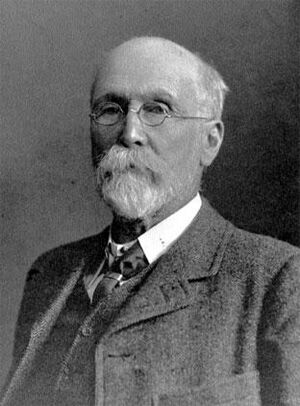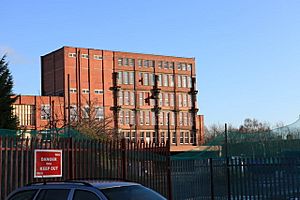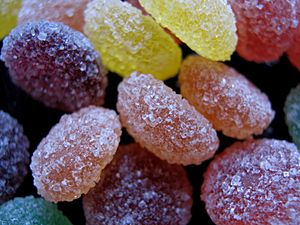Rowntree's facts for kids
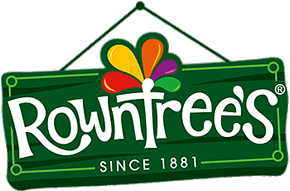 |
|
|
Trade name
|
Rowntree's |
|---|---|
|
Formerly
|
|
| Public | |
| Industry | Confectionery |
| Founded | 1862 |
| Founder | Henry Isaac Rowntree |
| Headquarters | York, England |
|
Key people
|
Joseph Rowntree |
| Products | Sweets |
| Brands |
|
| Parent | Nestlé |
Nestlé UK Ltd. is a British company known for its sweets and chocolates. It trades under the name Rowntree's. The company was first based in York, England. Rowntree's created many famous sweets. These include Kit Kat (from 1935) and Aero (also 1935). They also made Fruit Pastilles (1881) and Smarties (1937).
Later, Rowntree's joined with another company called Mackintosh's in 1969. Together, they made popular brands like Rolo and Quality Street. Rowntree's also launched After Eight mint chocolates in 1962. The Yorkie and Lion bars came out in 1976. Rowntree's was also one of the first to create the festive selection box. This is a gift box with different sweets, popular at Christmas for over 100 years.
The company started in 1862. It had strong links to the Quaker community, who believed in helping others. For much of the 1800s and 1900s, Rowntree's was one of the top three sweet makers in the UK. The other two were Cadbury and Fry, also started by Quakers.
In 1981, Rowntree's won the Queen's Awards for Enterprise. This award was for their great work in international trade. In 1988, Nestlé bought the company. At that time, Rowntree's was the fourth-largest sweet maker in the world. The Rowntree brand is still used today for Nestlé's jelly sweets. These include Fruit Gums and Fruit Pastilles. Rowntree's stopped being a separate company in 1991. It then became part of Nestlé UK.
Contents
History of Rowntree's Sweets
How Rowntree's Began
Rowntree's started in 1862 in York, England. It was founded by Henry Isaac Rowntree, who was a Quaker. He bought the business from the Tuke family.
In 1864, Rowntree bought an old iron factory. He moved his sweet production there. By 1869, only 12 men worked at the factory. Henry Rowntree faced money problems around this time. His brother, Joseph Rowntree, joined him as a full partner. This is when H.I. Rowntree & Co officially began.
In 1881, Rowntree's launched Rowntree's Fruit Pastilles. These sweets were a big success. They helped the company grow a lot. By 1887, Fruit Pastilles made up about a quarter of all the sweets the company sold. This success allowed Rowntree's to buy new machines. These machines helped them make chocolate without cocoa butter. This meant they could compete with Cadbury's popular Cocoa Essence. In the 1890s, Rowntree's grew from a small family business into a large factory. Sales more than quadrupled as people wanted more sweets.
In 1889, Seebohm Rowntree set up a small lab. Here, they tested ingredients and rival products. By 1890, the factory was too small. Rowntree's bought a large piece of land on the edge of York. They had seen how well Cadbury's purpose-built factory worked. In 1893, the company introduced Rowntree's Fruit Gums.
By 1897, the company needed more money to grow. It became a public company called Rowntree & Co. Some people said Rowntree's was slow to create new products. They also said it was slow in marketing compared to Cadbury. Joseph Rowntree often copied successful ideas from others. For example, he copied Cadbury's Cocoa Essence and French fruit pastilles. Under his leadership, the company did not invent many new things on its own. Around 1898, the company bought its own cocoa farms. In 1899, Rowntree's made its first milk chocolate bar.
Growth and New Products (1900-1945)
Rowntree's found it hard to make milk chocolate as good as Cadbury's Dairy Milk. Joseph Rowntree even thought milk chocolate was just a passing trend. This became a big problem after 1914. British people started to prefer milk chocolate over bitter cocoa products. Rowntree's two main rivals, Cadbury and Fry, joined together in 1918. Rowntree's was asked to join, but they said no. The Rowntree board was unsure what to do. Should they make high-quality products in small amounts? Or should they make lots of cheaper sweets? When Seebohm Rowntree became chairman in 1923, the company was struggling. By 1930, Rowntree's was almost bankrupt.
In 1926, Rowntree's bought a Canadian company called Cowan Company. From 1931, Rowntree of Canada started making Mackintosh toffees. In 1927, the company began selling its fruit gums in tubes. Its pastilles followed in 1928, also in tubes. This is the packaging we know today.
George Harris became the marketing manager for chocolate bars in 1931. He had learned new marketing ideas in the United States. He helped the company become successful again in the 1930s. In 1932, Rowntree's hired a new advertising company. This company did a lot of research to find out what customers wanted. Because of this research, the Black Magic box of chocolates was launched in 1934.
In 1935, Rowntree's stopped trying to compete directly with Cadbury Dairy Milk. Instead, in May 1935, they launched Aero. This was a new kind of bubbly milk chocolate. The Chocolate Crisp, a wafer and chocolate bar, also launched in 1935. This bar later became known as the Kit Kat. In 1937, the Dairy Box of chocolates was launched. This used the same research as Black Magic. Chocolate beans were first sold loose in 1938. Later, they were put into cardboard tubes and called Smarties. Polo, the mint with a hole in the middle, was created in 1939. But its launch was delayed by World War II. George Harris became the company chairman in 1941.
Expansion and Mergers (1945-1988)
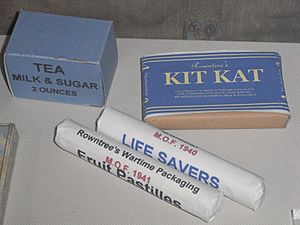
Rowntree's started selling its products in Europe in the 1960s. They built factories in places like Hamburg and Dijon. After Eight thin mint chocolates were launched in 1962.
In 1969, Rowntree's turned down a big offer from General Foods to buy the company. In the same year, Rowntree's made a deal with Hershey in the US. Hershey would make Rowntree products under license in America. Rowntree's then merged with John Mackintosh and Co in 1969. They became Rowntree Mackintosh. Mackintosh made sweets like Rolo, Munchies, Caramac, and Quality Street. Hershey's started selling Kit Kat in the US in 1970, and Rolo in 1971.
In 1971, Rowntree Mackintosh bought Menier Chocolate from France. In 1972, they also bought Hoadley's Chocolates in Australia. This company had created products like the Violet Crumble.
The Yorkie and Lion chocolate bars were introduced in 1976. In 1978, the deal with Hershey was changed. Hershey got the rights to the Kit Kat and Rolo brands in the US forever.
Ken Dixon became chairman and chief executive in 1981. Between 1981 and 1987, Rowntree's spent a lot of money. They upgraded their factories and bought new machines. This helped them make many of their popular brands, like Kit Kat, After Eights, and Smarties, much faster.
Between 1983 and 1987, Rowntree's bought many other companies. These included Tom's Foods, Laura Secord Chocolates, and Sunmark confectionery.
Between 1982 and 1987, the number of staff in the UK went down. In 1987, Rowntree's had 25 factories in nine countries. They employed 33,000 people. Almost 16,000 of these worked in their eight UK locations. The company's total sales were £1.4 billion. The UK and Ireland made up 40% of these sales.
Nestlé Takes Over Rowntree's
On April 13, 1988, a Swiss sweet company called Jacobs Suchard started buying Rowntree's shares. Rowntree's shares had not been doing very well, but they were starting to get better. By 9:15 am, Jacobs Suchard owned almost 15% of the company. Because of this, the head of Nestlé, Helmut Maucher, called Kenneth Dixon, the chairman of Rowntree's. Nestlé offered to buy Rowntree's to protect it from Jacobs Suchard. Nestlé was the biggest food company in the world. They had been interested in Rowntree's before. But the Rowntree's board always fought against any attempts to buy them. Nestlé had never tried to take over a company that didn't want to be bought. However, Nestlé was worried that Rowntree's might fall into the hands of one of its main rivals. Rowntree's was the fourth-largest chocolate maker in the world. It had 7% of the global market.
Nestlé eventually bought Rowntree's for £2.55 billion. Nestlé always thought Rowntree's would be a great fit for its own business. Nestlé was strong in making large chocolate bars. Rowntree's was strong in making individual chocolate bars and sweets. Rowntree's popular global brands were the main reason Nestlé was interested. Nestlé believed that combining the two companies could save between 5% and 15% of Rowntree's running costs.
The takeover was a bit controversial. This was because Nestlé itself was protected from similar takeovers under Swiss law. After Nestlé bought Rowntree's, the chocolate ranges started to be called "Nestlé Rowntree". Later, the Rowntree name was removed from most packaging. It stayed only on Rowntree's Cocoa and the Fruit Pastilles and Fruit Gums. The Mackintosh name was also removed from most products.
Between 1988 and 1994, the Nestlé Rowntree workforce was reduced by 2,000 people. The Nestlé Rowntree factory in Norwich closed in 1994. The production of Rolo, Yorkie, and Easter eggs moved to York.
In September 2006, Nestlé announced that Smarties production would move to Hamburg, Germany. This led to 645 job losses at the York factory. Dairy Box production moved to Spain, and Black Magic to the Czech Republic.
In May 2009, Nestlé launched a new jelly sweet called Rowntree's Randoms. In April 2012, they launched another new jelly sweet, Fruit Bottles. Both were under the Rowntree's brand.
Nestlé has invested over £200 million in the Rowntree business since 1988. This has made the York site one of the world's largest sweet factories. Nestlé's global research center for sweets is also in York. It doubled in size after a £7 million investment.
Popular Rowntree's Products Today
The most famous products still sold under the Rowntree name are Rowntree's Fruit Gums, Rowntree's Fruit Pastilles, and Jelly Tots. Jelly Tots are soft, chewy sweets with fruit flavors. They are round and covered in sugar. They contain 25% fruit juices and no fake colors or flavors. Dr Brian Boffey invented Jelly Tots in Leeds while working for Rowntree's. Jelly Tots were launched in 1965. They quickly became a popular children's sweet in Europe. Rowntree's Randoms were introduced in 2009.
The Rowntree brand is also used for some ice lollies. These are made by R&R Ice Cream for Nestlé. The brand competes with other fruit-flavored sweets from companies like Cadbury's.
Advertising History
Before 1897, the company did not advertise much. They believed that good products would sell themselves. In 1897, when they became a public company, they hired an advertising agency.
In 1932, Rowntree's changed their advertising agency. The new agency, J. Walter Thompson, did a lot of research. They wanted to find out what customers really wanted.


